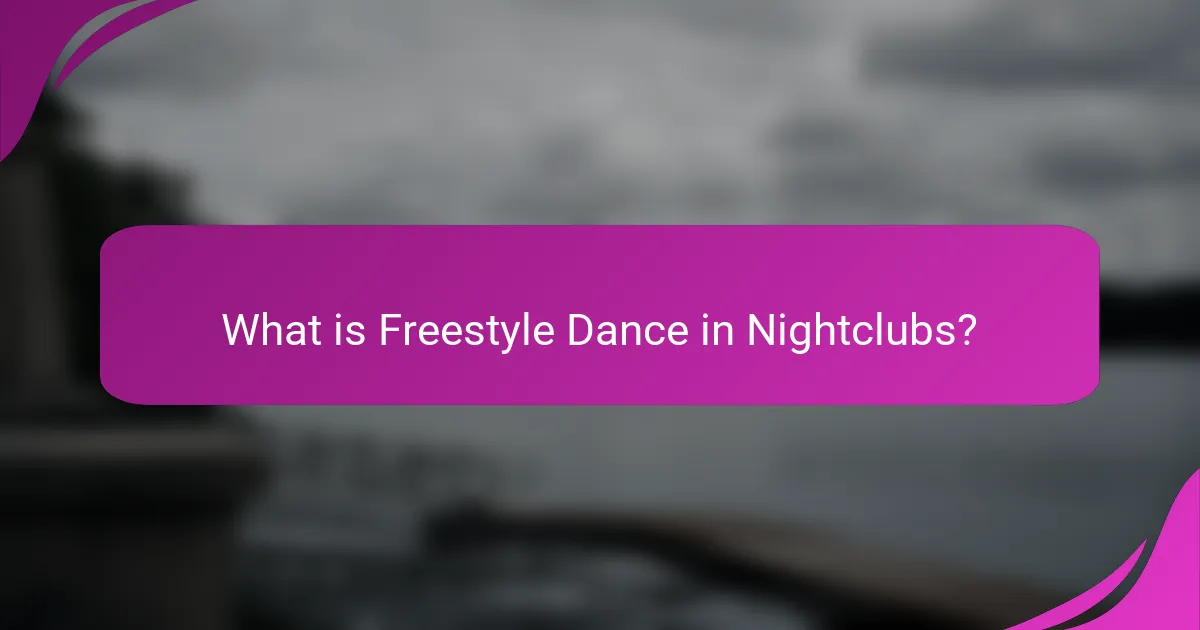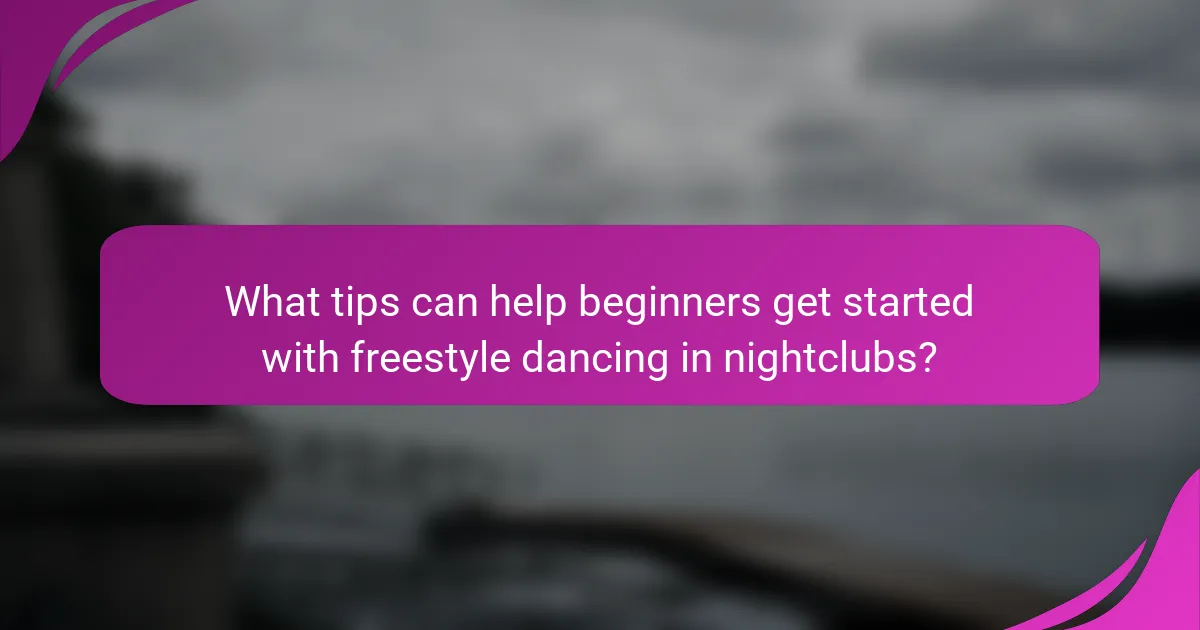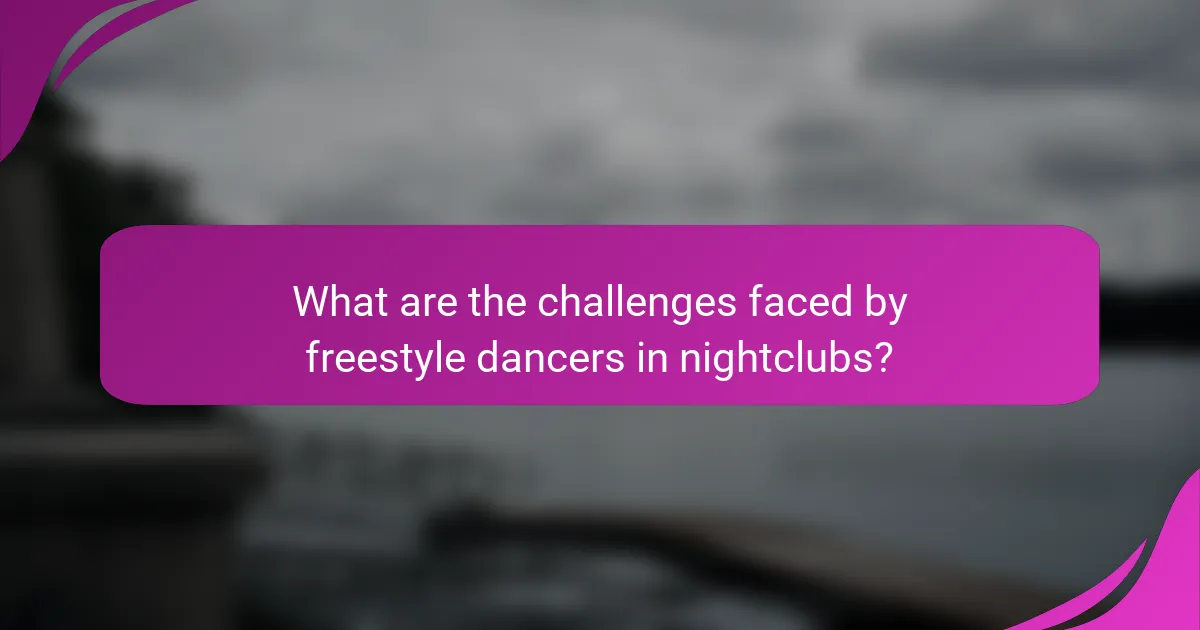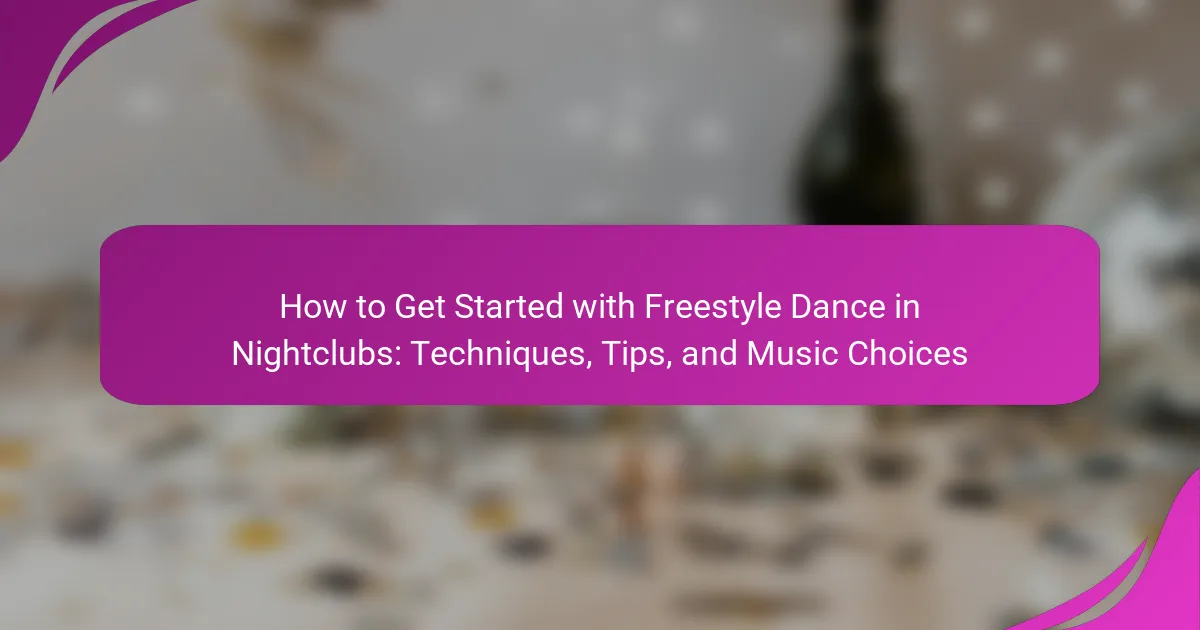Freestyle dance in nightclubs is an improvisational dance style that emphasizes self-expression through spontaneous movements in response to music. This article provides essential guidance for beginners looking to engage in freestyle dancing, including tips on feeling the music, practicing basic moves, and observing experienced dancers for inspiration. It also addresses common challenges faced by freestyle dancers, such as navigating crowded environments, adapting to varying music styles, and managing social pressure. Furthermore, the article highlights the importance of relaxation and enjoyment in the dance experience, as well as the potential benefits of joining dance classes for skill improvement.

What is Freestyle Dance in Nightclubs?
Freestyle dance in nightclubs is an improvisational style of dancing. It allows individuals to express themselves through spontaneous movements. Dancers often respond to the music’s rhythm and beat. This form of dance is characterized by its lack of structured choreography. Participants can incorporate various dance styles, such as hip-hop, jazz, or contemporary. Freestyle dance encourages creativity and personal expression. Nightclubs provide a vibrant atmosphere that enhances this form of dance. The social aspect of freestyle dancing fosters connection among dancers and audiences.
How does freestyle dance differ from other dance styles?
Freestyle dance differs from other dance styles by emphasizing improvisation and personal expression. Unlike structured dance forms, freestyle allows dancers to create movements spontaneously. This style encourages individual creativity, as there are no set steps or choreography to follow. Dancers often respond to the music in real-time, showcasing their unique interpretations. Freestyle dance is commonly seen in social settings, such as nightclubs and parties, where the atmosphere promotes free movement. In contrast, other dance styles often require formal training and adherence to specific techniques. This flexibility in freestyle dance fosters a sense of freedom and enjoyment among participants.
What are the key characteristics of freestyle dance?
Freestyle dance is characterized by spontaneous and improvised movement. Dancers express themselves uniquely without predetermined steps. This style emphasizes personal interpretation of music. Freestyle dance incorporates various dance forms and influences. It allows for creativity and individuality in performance. The connection to the music is central, guiding movements. Freestyle dance often occurs in social settings, like nightclubs. Dancers engage with others, creating a dynamic atmosphere.
Why is freestyle dance popular in nightclub settings?
Freestyle dance is popular in nightclub settings due to its emphasis on personal expression. Dancers can showcase their individuality and creativity without strict choreography. The energetic atmosphere of nightclubs encourages spontaneous movement. Music genres like electronic dance music often inspire freestyle dancing. This genre’s beats create an engaging environment for improvisation. Additionally, freestyle dance fosters social interaction among club-goers. It allows dancers to connect through shared rhythm and movement. The lack of formal structure makes it accessible to everyone. Consequently, this inclusivity contributes to its widespread appeal in nightlife.
What skills are essential for freestyle dancing in nightclubs?
Essential skills for freestyle dancing in nightclubs include rhythm, body control, and improvisation. Rhythm allows dancers to move in sync with the music. Body control is crucial for executing movements fluidly and confidently. Improvisation enables dancers to create spontaneous movements that match the energy of the crowd. Additionally, spatial awareness helps dancers navigate the dance floor effectively. Creativity is vital for developing unique dance styles. Social skills enhance interaction with other dancers, fostering a lively atmosphere. These skills collectively contribute to an engaging freestyle dance experience in nightclubs.
How can rhythm and musicality enhance freestyle dancing?
Rhythm and musicality enhance freestyle dancing by providing structure and expression. Rhythm helps dancers synchronize their movements with the beat of the music. This synchronization creates a cohesive performance that captivates the audience. Musicality allows dancers to interpret the music’s nuances and emotions. It encourages creativity and individuality in each performance. Dancers who master rhythm can execute more complex moves. Studies show that dancers with strong musicality often receive higher scores in competitions. This connection between music and movement elevates the overall dance experience.
What role does body movement play in freestyle dance?
Body movement is essential in freestyle dance as it expresses creativity and individuality. Freestyle dance allows dancers to interpret music through spontaneous body movements. This form of dance emphasizes personal style and fluidity. The connection between music and movement is crucial for improvisation. Dancers often use body movement to convey emotions and stories. Research indicates that physical expression enhances emotional well-being. Studies show that movement can improve coordination and rhythm. Overall, body movement is the foundation of freestyle dance, enabling self-expression and artistic freedom.
What are the common techniques used in freestyle dance?
Common techniques used in freestyle dance include isolation, body waves, and footwork variations. Isolation involves moving one part of the body independently while keeping others still. Body waves create fluid movements that ripple through the torso. Footwork variations add rhythm and style, incorporating quick steps and transitions. Additionally, spins and turns enhance dynamic expression. Freestyle dancers often blend these techniques to create unique performances. Each technique contributes to the overall fluidity and creativity of the dance style.
How can one develop improvisation skills for freestyle dance?
To develop improvisation skills for freestyle dance, one should practice regularly. Engaging in freestyle dance sessions enhances spontaneity and creativity. Listening to various music genres can inspire different movements. Experimenting with different styles helps in discovering personal expression. Observing other dancers provides new ideas and techniques. Joining dance workshops or classes can offer structured guidance. Recording and reviewing one’s performances can highlight areas for improvement. Consistent practice leads to greater confidence and fluidity in movement.
What are some basic freestyle dance moves to learn?
Basic freestyle dance moves to learn include the two-step, body roll, and moonwalk. The two-step involves shifting weight from one foot to the other while stepping side to side. This move is fundamental and can be adapted to various music tempos. The body roll is a smooth movement that flows from the head to the hips. It adds fluidity and style to freestyle dancing. The moonwalk creates an illusion of gliding backward while appearing to walk forward. This iconic move is widely recognized and can impress onlookers. Practicing these moves helps build confidence and rhythm in freestyle dance.

What tips can help beginners get started with freestyle dancing in nightclubs?
To get started with freestyle dancing in nightclubs, beginners should focus on a few key tips. First, feel the music and let it guide your movements. Understanding the rhythm is essential for freestyle dancing. Next, practice basic dance moves at home to build confidence. Simple steps, like side shuffles or body waves, can be effective. Additionally, observe other dancers in the club. This can provide inspiration and help you learn new techniques.
It’s also important to relax and have fun. Freestyle dancing is about self-expression, not perfection. If you make mistakes, just keep moving. Finally, consider joining a dance class to improve your skills. Classes can provide structured learning and boost your confidence in a social setting.
How can one build confidence while dancing in public?
To build confidence while dancing in public, practice regularly in private settings. This helps familiarize yourself with movements and boosts comfort. Start with simple steps and gradually incorporate more complex routines. Visualize yourself dancing confidently before performing. Positive self-talk reinforces your belief in your abilities. Joining a dance class or group provides support and encouragement from peers. Research shows that social dancing can enhance self-esteem and reduce anxiety. Engaging with music you love makes the experience enjoyable and less intimidating.
What are effective ways to practice freestyle dancing?
Effective ways to practice freestyle dancing include regularly attending dance classes and workshops. These settings provide structured learning and feedback from instructors. Practicing in front of a mirror helps dancers observe and refine their movements. Recording dance sessions allows for self-evaluation and improvement. Joining a dance group fosters community and motivation. Freestyling to different music genres enhances adaptability and creativity. Consistent practice, at least a few times a week, builds muscle memory and confidence. Engaging in improvisation exercises encourages spontaneity and expression.
How can social interactions enhance the freestyle dancing experience?
Social interactions can significantly enhance the freestyle dancing experience by fostering a sense of community. Engaging with others while dancing encourages creativity and spontaneity. Dancers often feed off each other’s energy, leading to more dynamic performances. Social interactions also provide opportunities for learning and feedback. Observing peers can inspire new moves and styles. Additionally, shared experiences create lasting memories, making dancing more enjoyable. Studies show that social connections in dance environments can increase motivation and participation. This communal aspect of freestyle dancing enriches the overall experience.
What should beginners consider when choosing music for freestyle dancing?
Beginners should consider the tempo and rhythm of the music when choosing songs for freestyle dancing. A faster tempo encourages energetic movements, while slower beats allow for more fluid and expressive styles. The genre of the music also plays a crucial role. Popular genres for freestyle include hip-hop, funk, and electronic dance music.
Understanding the structure of the song is important. Songs with clear verses and choruses provide opportunities for varied dance expressions. Additionally, personal preference should guide the selection. Enjoying the music enhances confidence and creativity while dancing.
Finally, it’s beneficial to choose tracks that are well-known. Familiarity with a song can lead to more comfortable and spontaneous movements.
How does tempo influence freestyle dance choices?
Tempo significantly influences freestyle dance choices by dictating the rhythm and energy of movements. A faster tempo encourages more energetic and dynamic dance styles. Dancers often incorporate quick footwork and sharp movements to match the beat. Conversely, a slower tempo allows for smoother, more fluid motions. This can lead to more expressive and controlled dance choices. Research indicates that dancers adapt their styles to align with the tempo of the music they are listening to. This adaptation enhances their overall performance and connection to the music. Thus, tempo serves as a crucial factor in shaping freestyle dance expression.
What genres of music are best suited for freestyle dance in nightclubs?
Electronic dance music (EDM) is best suited for freestyle dance in nightclubs. This genre includes subgenres like house, techno, and trance. EDM features strong beats and rhythmic patterns. The tempo typically ranges from 120 to 130 BPM, ideal for dancing. Hip-hop is another genre that complements freestyle dance well. It encourages improvisation and personal expression. The beats in hip-hop music often provide a solid foundation for creative movement. Additionally, funk and disco are great for freestyle dancing. They offer upbeat tempos and catchy melodies. These genres promote a fun, energetic atmosphere. Overall, these genres enhance the freestyle dance experience in nightclubs.

What are the challenges faced by freestyle dancers in nightclubs?
Freestyle dancers in nightclubs face several challenges. One major challenge is the crowded environment. Limited space can restrict movement and creativity. Another issue is the varying music styles played throughout the night. Dancers must quickly adapt to different beats and rhythms. Additionally, lighting can be a problem. Strobe lights and dim settings may hinder visibility and coordination.
Social pressure is also significant. Dancers often feel the need to perform well in front of an audience. This can lead to anxiety and self-doubt. Furthermore, physical fatigue can arise from prolonged dancing. This affects stamina and performance quality. Lastly, the presence of alcohol can influence the atmosphere. It may lead to unpredictable interactions with other club-goers.
How can one overcome stage fright while dancing in clubs?
To overcome stage fright while dancing in clubs, practice deep breathing techniques. Deep breathing helps calm the nervous system. Visualization can also be effective. Picture yourself dancing confidently and enjoying the moment. Another method is to focus on the music rather than the audience. Engaging with the beat can shift attention away from self-consciousness. Gradually exposing yourself to dancing in front of others can build confidence. Start with friends or smaller groups before larger crowds. Lastly, remember that everyone makes mistakes. Embracing imperfections can reduce anxiety and enhance enjoyment.
What strategies can help manage distractions in a nightclub environment?
To manage distractions in a nightclub environment, focus on creating a personal space. Establishing a designated area helps minimize outside interruptions. Use noise-canceling headphones to block out excessive sound. This technique allows for better concentration on dancing. Engage in pre-dance routines to mentally prepare and reduce anxiety. Practicing mindfulness can help maintain focus amidst chaos. Utilizing visual cues, like specific dance moves, can anchor attention. Lastly, setting clear personal goals for each outing enhances motivation and reduces distractions.
What are some common mistakes to avoid when freestyle dancing?
Common mistakes to avoid when freestyle dancing include overthinking movements. This can lead to stiffness and a lack of natural flow. Another mistake is neglecting to connect with the music. Dancing without rhythm can make movements feel disjointed. Additionally, many dancers fail to engage with their audience. Ignoring the crowd can reduce the energy of the performance. Poor body awareness is also a frequent issue. Dancers may not realize how their posture affects their overall presence. Lastly, some dancers may focus too much on technical skills instead of expressing themselves. This can hinder creativity and personal style.
How can one ensure they stay in sync with the music?
To ensure one stays in sync with the music, they should actively listen to the beat and rhythm. Focusing on the tempo helps in timing dance movements. Practicing with a metronome can enhance timing skills. Additionally, dancing to various genres improves adaptability to different rhythms. Regular practice in different environments aids in building a natural connection with the music. Engaging with other dancers can provide feedback and enhance synchronization. These methods have been shown to improve musicality in dance.
What should dancers keep in mind regarding personal space and safety?
Dancers should maintain awareness of personal space and safety to prevent injuries and discomfort. Respecting personal space helps create a comfortable environment for all participants. Dancers should establish a safe distance from others while performing. This distance varies based on the size of the dance floor and the number of people present. Awareness of surroundings is crucial to avoid collisions. Dancers should also be mindful of their movements and the movements of others. Keeping an eye on nearby dancers can help prevent accidents. Additionally, understanding the venue’s layout can enhance safety. Familiarity with exits and potential hazards is important for quick responses in emergencies.
What are the best practices for a successful freestyle dance experience in nightclubs?
To have a successful freestyle dance experience in nightclubs, focus on confidence and self-expression. Confidence enhances your presence on the dance floor. Self-expression allows you to connect with the music and your surroundings. Choose music that resonates with you; this will inspire your movements. Pay attention to the rhythm and beats; this helps in synchronizing your dance style. Engage with the crowd to create a lively atmosphere. Observe other dancers to learn new styles and techniques. Practice regularly to improve your skills and comfort level. Lastly, stay hydrated and take breaks to maintain energy throughout the night.
Freestyle dance in nightclubs is an improvisational dance style that emphasizes personal expression and spontaneity, allowing dancers to interpret music through various movements without structured choreography. This article covers essential techniques, skills, and tips for beginners looking to engage in freestyle dancing, including the importance of rhythm, body movement, and musicality. It also explores the social dynamics of freestyle dance in nightclub settings, the challenges dancers may face, and best practices for a successful experience on the dance floor. Additionally, it provides guidance on music selection and overcoming common obstacles, ensuring readers are well-equipped to start their freestyle dance journey.
